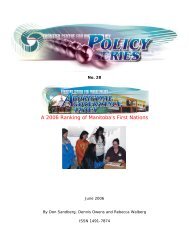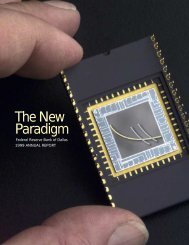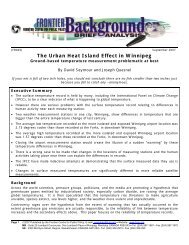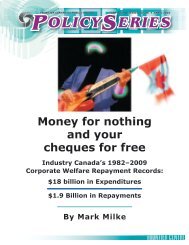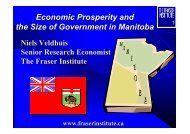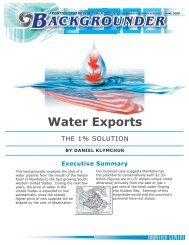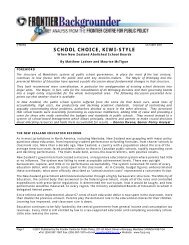The New Paradigm - Federal Reserve Bank of Dallas
Create successful ePaper yourself
Turn your PDF publications into a flip-book with our unique Google optimized e-Paper software.
O<br />
ut on a<br />
<strong>New</strong>-<strong>Paradigm</strong><br />
Limb<br />
"<strong>Paradigm</strong>" is a pretty fancy word<br />
for a country boy. My understanding<br />
<strong>of</strong> it is illustrated by the familiar<br />
recipe for boiling a frog. You don't<br />
boil a frog by dropping him into<br />
boiling water. He'll jump out.<br />
Instead, you drop him in cold<br />
water and raise the heat. <strong>The</strong> frog<br />
won't jump because he doesn't<br />
realize his paradigm is shifting.<br />
I believe our economy's paradigm<br />
has been shifting. But like the<br />
frog, many <strong>of</strong> us haven't noticed<br />
because the change has been gradual.<br />
Some attribute its improvement<br />
to good luck and temporary<br />
factors, or "positive supply shocks"<br />
in economists' jargon. We have<br />
been lucky, and some <strong>of</strong> our good<br />
fortune has been based on temporary<br />
factors. But we at the <strong>Dallas</strong><br />
Fed believe there's more to it than<br />
that—a lot more.<br />
We believe once-in-a-century<br />
advances in technology are transforming<br />
our economy. <strong>The</strong> computer<br />
chip is doing for today's<br />
knowledge economy what electricity<br />
did for our industrial economy a<br />
century ago. Synergies in technology<br />
are driving an acceleration in<br />
productivity growth that enables us<br />
to grow faster with less inflation.<br />
Economic progress is speeding up;<br />
the speed limit is rising.<br />
Technology is the main force<br />
driving the <strong>New</strong> Economy, but not<br />
the only one. Deregulation <strong>of</strong> key<br />
industries is a factor. Increased<br />
worldwide competition is another.<br />
<strong>The</strong> collapse <strong>of</strong> communism and<br />
hard-core socialism is part <strong>of</strong> the<br />
mix, along with the fall <strong>of</strong> the Iron<br />
Curtain in Europe and the protectionism<br />
curtain in Latin America<br />
and elsewhere. Freer trade and<br />
investment throughout the world<br />
are factors. Efficient U.S. capital<br />
markets and the unique venture<br />
capital system serving high tech<br />
are important. So is the switch<br />
from budget deficits to surpluses.<br />
<strong>The</strong> Fed has done its part by<br />
reducing inflation. In the inflationary<br />
environment <strong>of</strong> the 1970s,<br />
squeezed pr<strong>of</strong>its could be restored<br />
by raising prices, with confidence<br />
that competitors would go along.<br />
Today's disinflationary environment<br />
shifts the burden to productivity-enhancing<br />
cost cutting as the<br />
main route to higher pr<strong>of</strong>its.<br />
While many factors are important<br />
to the <strong>New</strong> Economy, our<br />
essay focuses on technology. It<br />
helps answer the skeptics who find<br />
nothing new in the <strong>New</strong> Economy.<br />
I'm on record saying the Internet<br />
changes everything. I may exaggerate.<br />
"Things are different this time"<br />
are infamous last words that put me<br />
out on a limb. So be it. <strong>The</strong> greater<br />
exaggeration is to say nothing has<br />
changed, except, perhaps, some <strong>of</strong><br />
the old economy's parameters.<br />
+<br />
We've been growing<br />
faster than potential<br />
and sustaining the<br />
unsustainable for four<br />
years and counting.<br />
1999 was another good year for<br />
new-paradigm optimists. Real GDP<br />
grew over 4 percent. Payroll employment<br />
increased by 2.7 million<br />
workers, or 2.1 percent. Unemployment<br />
fell to 4.1 percent. And core<br />
inflation continued to decline, to 2<br />
percent or below, depending on the<br />
measure. <strong>The</strong> year ended with the<br />
expansion poised to become America's<br />
longest.<br />
Real GDP growth has averaged 4<br />
percent for the past four years, with<br />
declining inflation. This almost<br />
doubles the 2 percent to 2.5 percent<br />
not long ago considered the<br />
maximum noninflationary potential.<br />
But we've been growing faster<br />
than potential and sustaining the<br />
<strong>Federal</strong> <strong>Reserve</strong> <strong>Bank</strong> <strong>of</strong> <strong>Dallas</strong> 1999 ANNUAL REPORT




